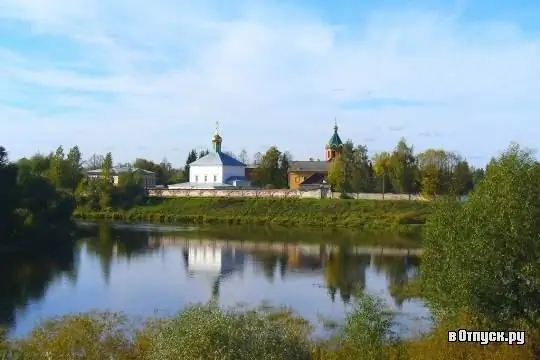
Description of the attraction
The Holy Spirit Monastery is located in the Novgorod region, in the Borovichi district, on Nevsky street. Until now, the exact date of the construction of the monastery has not been established, because all the monastery archives were destroyed by fire in 1732. The only fact that can be considered true is that the Iakovlev Monastery is one of the most ancient monasteries in Russia. The foundation of the monastery took place at the very beginning of the 14th century, when the great Moscow prince Ivan Kalita reigned on the throne. On the ancient shrine dedicated to St. James, an inscription has survived to this day, according to which it can be concluded that the foundation of the Holy Spirit Monastery took place in 1327, and its cathedral church was built in 1345.
The Jacob Monastery received the greatest fame during the second half of the 16th century, which was associated with the transfer of the holy relics of Jacob to its building in 1545. The reigning Ivan the Terrible at that time had a great love and weakness for the newly-minted saints, as well as for the miraculous sacred icons, and that is why the tsar endowed this monastery with arable land and land plots.
Throughout 1613, during the Time of Troubles, the Holy Spirits of James Monastery was brutally plundered by a small Swedish army, as well as a group of Poles. In 1654, the foundation of the Iversky Monastery took place with the support of Patriarch Nikon in Valdai. It was ordered to transfer the Borovichi shrine to this monastery. At this time, the Iakovlev Monastery, which still had a particle of the relics of St. James, was completely attributed to the Valdai-Iversky Monastery.
It is known that in 1724, for a short period of time, the relics of the holy blessed prince Alexander Nevsky were kept in the monastery, which were transferred to the monastery by order of Peter the Great from the city of Vladimir to St. Petersburg. Beginning in 1741, the Borovichi Holy Spirit Monastery was assigned to the famous Alexander Nevsky Lavra. In 1809, in the city of Borovichi, more precisely in its central part, the opening of the Theological School took place, and until 1859 it was located in one of the buildings of the Holy Spirit Monastery.
In the winter of February-1918, the Borovichi district commission decided to completely close the St. James Monastery, and after that, on April 17 of the same year, the liquidation commission began its work. As a result, the monastery was closed, and all the churches belonging to it were turned exclusively into parish churches, the existence of which was short-lived. In 1920, church valuables made of silver, the weight of which exceeded more than 17 kg, were withdrawn from all the churches of the Borovichi Holy Spirit Monastery. After a certain period of time, all churches were closed, after which all signs that could remind of their cult purpose were destroyed. In addition, the bell tower was dismantled, and the old cemetery located at the monastery was destroyed.
During the Great Patriotic War, a hospital for prisoners of war was located in the area of the previously existing Holy Spirit Monastery. After some time, a military unit was located on the monastery territory.
In the fall of September 14, 2000, the Borovichi Iakovlev Monastery was nevertheless returned to the Orthodox Church, and in 2002 large golden domes and a golden cross were again erected on the Church of the Holy Spirit. Today, in the area where the St. James Monastery is located, there is the Bishop's Compound. On the opposite side of the Church of the Descent of the Holy Spirit on the Apostles, a sacred well belonging to Abbess Taisia Solopova, abbess of the small Leushinsky monastery, was restored. It was this woman who in 1861 received her blessing for monastic life and took the path of developing her own spiritual path, as reported by a memorial plaque attached to the building of the abbot's building. The so-called Taisin readings are held here every year.






